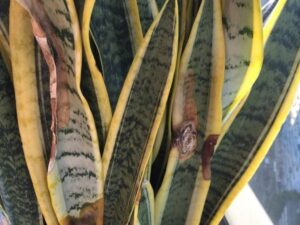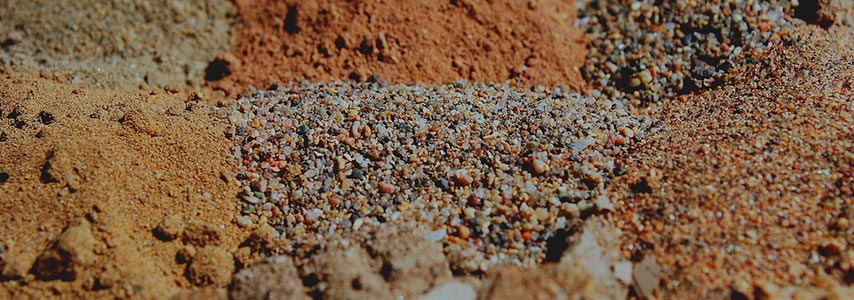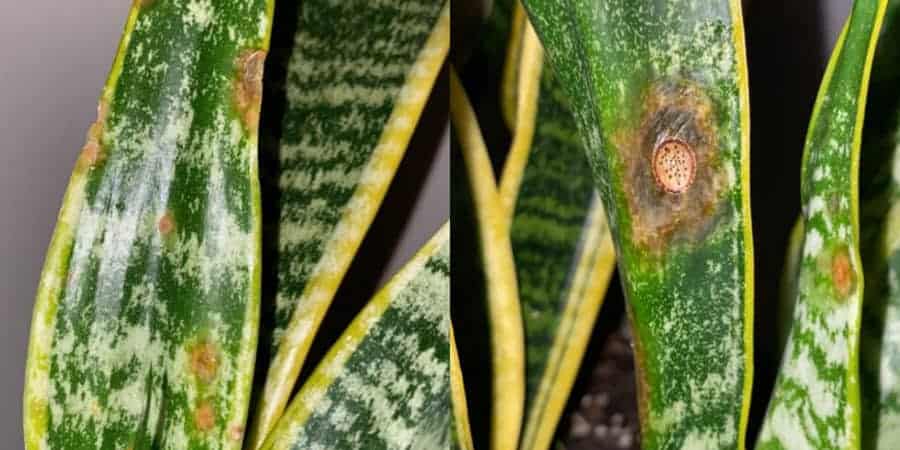Snake plants are very tough plants so we don’t really take care of them a lot and we think nothing would happen to them. But this is not true at all.
This plant may be very hardy but it still needs some care. Yet it still fights the problems on its own. But if you continue to neglect them, soon they’ll be wilting and dying. The good news is you can fix them easily if you go through the right process
So, why are the snake plants dying?
Incorrect watering, Lack of sunlight, Poor soil quality, Fungal disease, Pest problem, Cold damage, and Poor nutrient conditions are the common reasons for a dying snake plant.
In this article, I am going to discuss each of these problems and make it clear to you so that you can easily start to fix your precious snake plants.
So, let’s get started-
Why Is My Snake Plant Dying?

1. Incorrect Watering

Without a doubt, the most common issue for a dying snake plant is watering. If you overwater or under-water them continuously they will die at some point.
Snake plants thrive in arid conditions in most cases. So, if you keep watering them more than they need, they will become soft, turn yellow or brown at the tips and eventually start dying.
On the other hand, if you continue to water them very little, the snake plants will fall into a very stressful condition. As a result, they will wilt, turn yellow and die.
Though both overwatering and underwatering have the same symptoms, there is a way to tell the difference. The overwatered snake plant leaves will be soft and lumpy wherein the underwatered leaves will be crispy and brittle.
Control Measure
Before watering, allow the soil to dry out completely. Be very cautious about over-watering because it will cause fungal diseases like root rot to your snake plants.
If you suspect overwatering by seeing the soil damp and soggy, stop watering until the soil dries out completely. Make sure the pot or container has enough drainage holes in them.
But do not leave the snake plants underwatered for a very long time. Instead of maintaining a constant watering schedule, water when the soil dries out.
Now the greater question is how much to water?
Well, there is no fixed number. You have to water according to the soil needs. Sometimes they may require more watering, sometimes less. So, to save yourself from this guessing game you can use a moisture meter (our pick: Atree Soil 3-in-1 Soil Tester Kits)
2. Lack Of Sunlight

Snake plants do not require very much sunlight. This is why they make such good house plants. But still, they need a certain exposure to sunlight to thrive.
Without proper sunlight, the snake plants won’t be able to make enough food for themselves by photosynthesis. And without food, the leaves will first start to fade and then turn yellow or brown. Slowly they will die.
Control Measure
The snake plants will survive in both direct and indirect sunlight. But do not keep them in direct sunlight for too long.
Take your indoor snake plants outside and leave them for a couple of hours everyday if they don’t get indirect sunlight staying indoors. Also, you can place them near a window where it will get some morning sun.
3. Poor Soil

Poor draining soil is one of the big reasons for the snake plants dying. When the soil doesn’t drain properly they spread diseases that injure the roots.
Also, wrong soil pH affects the nutrient uptake severely and the snake plant starts dying at the roots. But before dying of this cause, the leaves will have yellow veins with light green leaves
Control Measure
The soil should be well-draining and the pots should have enough drainage holes. Make sure the potting mixture is free draining. You can purchase a soil mixture that’s specifically made for succulents (our pick: All Natural Succulent and Cactus Soil Mix by Perfect Plants)
The soil pH range should be 5-8. Check the soil with a pH meter and if it’s acidic then add some peat moss. If it’s alkaline then add some acidic fertilizer to bring the soil pH within the range.
4. Fungal Disease

Fungal diseases like root rot, leaf spot, blight, etc are the worst enemies of snake plants. The fungus that causes the diseases needs treatment immediately.
Because of root rot, the leaves get brown spots on them and start turning yellow. Likewise, in blight and leaf spots the plant gets yellow or brown spots on them and starts wilting. In all the fungal cases the snake plants die if they are not treated properly.
Control Measures
To fix the root rot of the snake plant apply a good fungicide that’s not toxic for us. Because we mostly have them as house plants so it’s better to think about safety. (our pick: Garden Safe Brand Fungicide)
Try these easy home remedies for root rot or any other fungal problems:
#Recipe 1:- Baking Soda Spray Recipe
Ingredients:
- 3 teaspoons of baking soda
- 1 tablespoon of vegetable oil
- 1 gallon of water
- 1 teaspoon of liquid dish soap
Steps:
- Mix everything and give a good shake
- Spray on the snake plants
- You can also pour some of the solutions on the soil
# Recipe 2:- Epsom Salt Spray Recipe
Ingredients
- 1 tablespoon of Epsom salt
- 2 liters of water.
Steps
- Mix the salt with water
- spray this solution every other week on your snake plants if the problem continues
Preventive Measures
Make sure to give your snake plants plenty of sunlight and good aeration. This will reduce the chances of fungal attacks. Don’t forget to sterilize the potting mixture before planting them in the pot.
Also, don’t wet the leaves. Water them in the morning so that any wet leaves can dry under the sun.
5. Pest Problems

Some insects like mealybugs and scales suck saps from the snake plants and cause many problems. You see, mealybugs inject toxins while sucking the saps and this deforms the snake plant leaves. Also, the bug secret honeydew that promotes mold growth.
As a result of their feeding, the leaves turn yellow, curl and fall off from the plant. Eventually, the snake plant dies if not treated in time.
Control Measure
Put some rubbing alcohol on a cloth and wipe off the leaves to get rid of these tiny insects but scale insects are hard to eliminate in this way. Spray an insecticide because otherwise these insects won’t go and your snake plant will keep dying. (our pick: Bonide (BND951) – Systemic House Plant Insect Control).
Try these homemade insecticide recipes if you want to control them naturally:
#Recipe:-1 Insecticidal Soap Recipe:
Ingredients:
- 250 ml of Alcohol
- half liter of water
- 2 teaspoons of liquid dish soap
Steps:
- Mix everything and put the solution into the sprayer
- Spray on both sides of the snake plant leaves because these insects mostly hide in the underside of the leaves.
#Recipe 2:- Neem Oil Recipe:
Ingredients
- 1 teaspoon of neem oil
- 1 liter of water
Steps
- Mix the ingredients and spray in the snake plants every week.
- Apply this every week as a preventive measure
6. Cold Damage
Snake plants are tropical plants so they don’t survive well in freezing temperatures. So, if they are exposed to frost or cold temperatures the leaves will turn black and the plant will die a sudden death.
Control Measure
They prefer to be in the temperature between 65°-80°F. So, when the temperature goes below 65 F move your snake plants indoors. And bring them outside in the summer.
7. Poor Nutrients
Snake plants need a good dose of nutrients to thrive. So, if your soil is lacking nutrients, the plant will become unhealthy and they will be dying because of it. The potted ones need feeding especially.
Control Measure
The solution is very simple. You have to feed them a good, balanced fertilizer during the growing season (our pick: Aquatic Arts All-purpose HousePlant Fertilizer). Always apply according to the recommendations on the fertilizer package to avoid fertilizer burn because they need a very little amount of nutrients.
Conclusion
Snake plants are very tough but if they lack the minimum amount of care they can be dying in front of your eyes. So, don’t forget to spend some time with them.
Water them only when the soil is dry, save them from cold, and provide them plenty of sunlight. Also, prevent the fungal attack and pest infestation. Soon your dying snake plants will revive themselves.
